Disclosure: This article contains affiliate links. We may earn a commission from purchases at no extra cost to you, which helps our travel content.
Returning to India always feels like reconnecting with a piece of myself that remains dormant in Sydney. Mumbai, particularly, holds a special resonance—a city where my Indian heritage breathes through chaotic streets and serene corners alike. Last winter, I embarked on a week-long photographic pilgrimage through this magnificent metropolis, armed with my camera and the dual perspective of both insider and outsider. The city unfurled before my lens as a tapestry of contradictions: colonial grandeur alongside makeshift dwellings, spiritual devotion amid commercial frenzy, timeless traditions coexisting with relentless modernity. What follows is my curated guide to Mumbai's most captivating photo locations—places where light, culture, architecture, and humanity converge to create images that tell stories beyond their visual elements. Whether you're a seasoned photographer or simply seeking to document your journey meaningfully, these 15 spots will offer you Mumbai's soul on a silver platter of light and shadow.
Dawn's Golden Hour: Marine Drive & Gateway of India
The first light in Mumbai feels like a gift—a brief, golden reprieve before the city fully awakens. I've learned over multiple visits that arriving at Marine Drive (locally known as the Queen's Necklace) before sunrise offers a photographic experience that transcends the typical tourist snapshot.
At 5:30 AM, I found myself nearly alone on the curved promenade, watching as the first light gilded the Arabian Sea. The iconic arc of streetlights still illuminated, creating a perfect leading line against the gradient sky. This is where patience becomes your greatest asset—wait for a solitary morning jogger or fisherman to enter your frame, adding that human element that transforms a pretty landscape into a story.
Just a short ride away, the Gateway of India presents an entirely different dawn narrative. Built to commemorate the visit of King George V and Queen Mary, this colonial monument now stands as a symbol of India's pre-independence history. Arriving before 7 AM allowed me to capture the structure without the usual crowds, with the Taj Mahal Palace Hotel creating a magnificent backdrop.
The interplay of light here is fascinating—the rising sun gradually illuminates the Gateway's yellow basalt arch while fishing boats create silhouettes on the water beyond. I found my best shots came from positioning low to the ground with my wide-angle lens, capturing both the monument's grandeur and the morning's atmospheric conditions.
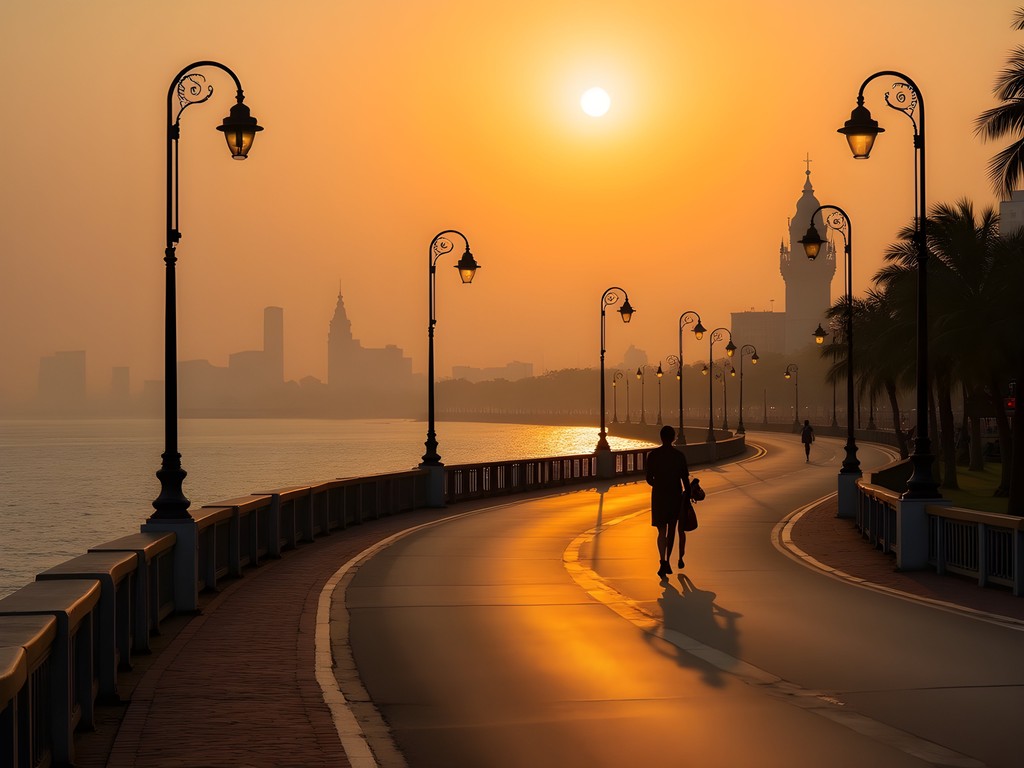
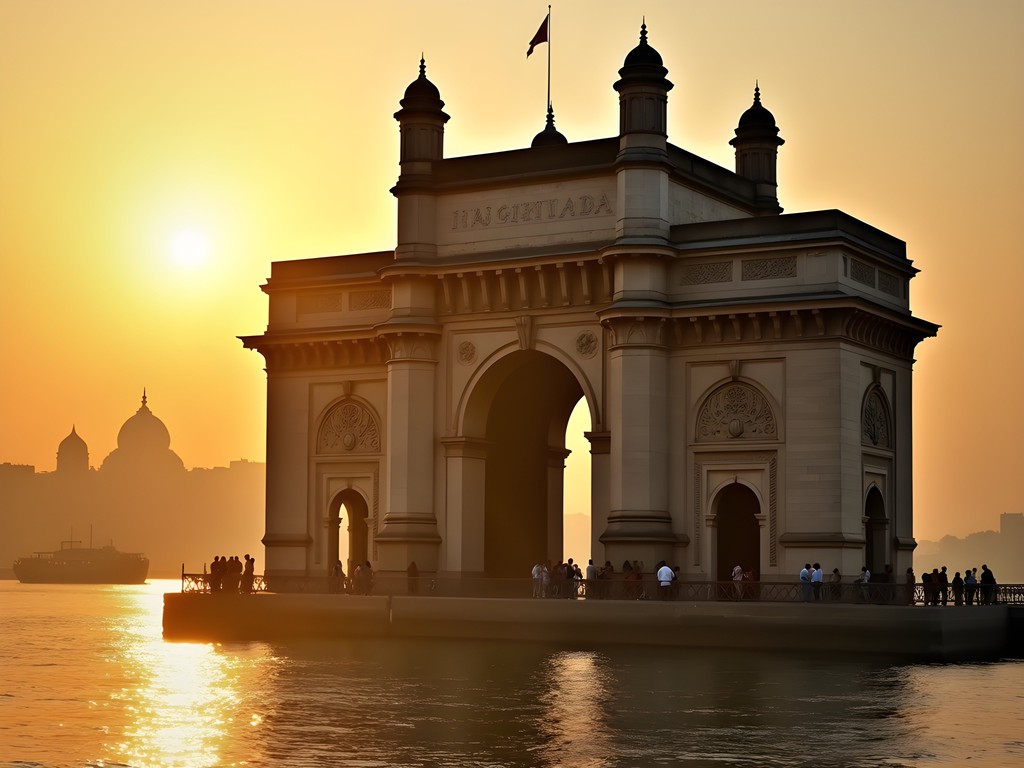
💡 Pro Tips
- Arrive at Marine Drive by 5:30 AM for the best light and minimal crowds
- Use a polarizing filter at Gateway of India to manage reflections on the water
- Include silhouettes of fishing boats and early visitors for scale and storytelling
Sacred Frames: Haji Ali Dargah & Banganga Tank
Mumbai's spiritual diversity offers photographers an opportunity to capture faith manifested in architectural splendor. The Haji Ali Dargah—a mosque and tomb floating like a mirage on a narrow causeway in the Arabian Sea—presents one of the city's most ethereal photographic subjects.
Timing is everything here. I arrived during low tide (check local tide tables) when the causeway is fully accessible, about two hours before sunset. The mosque appears to hover between sea and sky, its white domes and minarets reflecting in the surrounding waters. What makes this location photographically compelling is the journey itself—the narrow pathway stretching into the sea creates natural leading lines, with devotees in colorful attire providing movement and scale.
For a more intimate spiritual setting, I sought out Banganga Tank in Walkeshwar. This ancient water tank, surrounded by temples and shrines, offers a glimpse into a Mumbai that exists outside the frenetic pace of modernity. Arriving in late afternoon, I found the light filtering between buildings, creating dramatic shadows across the stepped tank.
The photographic challenge here lies in capturing both the architectural elements and the quiet moments of devotion—a woman floating flower offerings, elderly men in conversation on the steps, children playing in peripheral spaces. I found my telephoto zoom lens invaluable for isolating these intimate moments while still incorporating elements of the surrounding structures.
Both locations require a respectful approach—ask permission before photographing individuals in prayer, dress modestly, and be mindful of removing shoes when required in sacred areas. The resulting images carry not just visual impact but the emotional resonance of spaces where faith has been practiced for generations.
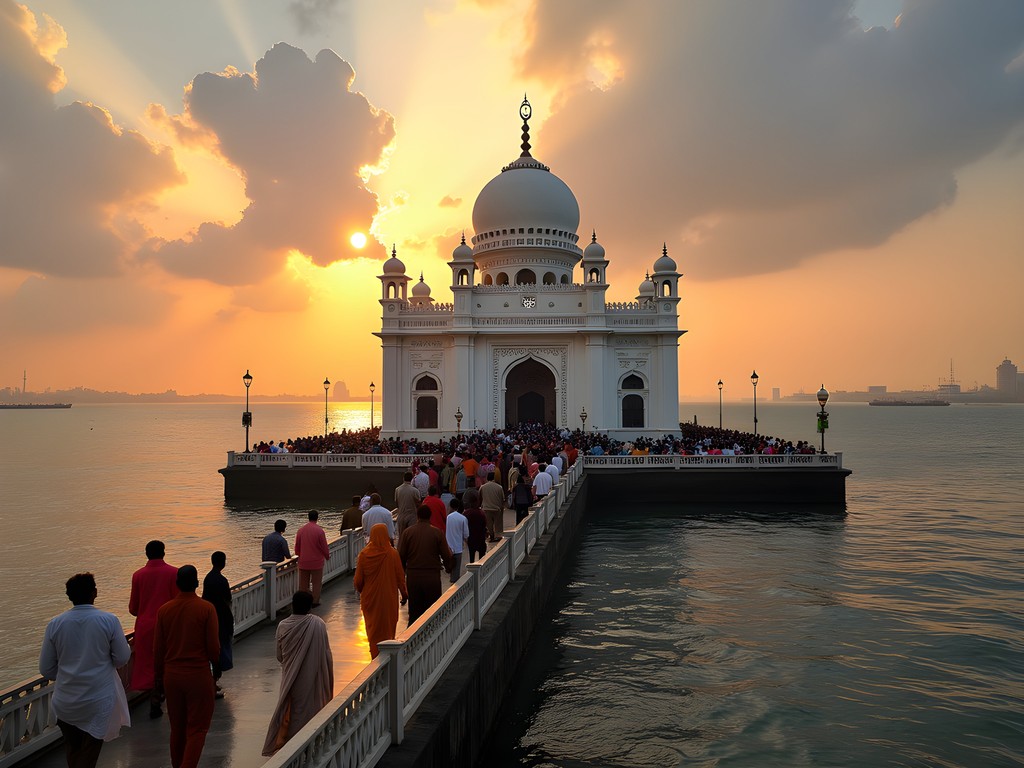

💡 Pro Tips
- Check tide tables before visiting Haji Ali Dargah—low tide offers the best access
- Visit Banganga Tank in late afternoon when light creates dramatic shadows on the steps
- Bring both wide-angle and telephoto lenses to capture architectural context and intimate moments
Colonial Elegance: CST Station & Kala Ghoda Art District
Mumbai's architectural identity is perhaps most dramatically expressed in its Victorian Gothic and Art Deco buildings—a UNESCO World Heritage ensemble that offers photographers endless compositional possibilities.
Chhatrapati Shivaji Terminus (formerly Victoria Terminus) stands as the crown jewel of this collection. This railway station, still functioning at full tilt, combines Gothic Revival architecture with traditional Indian elements in a way that captures the essence of colonial Mumbai. I've photographed this building dozens of times, but my most successful images came when I visited during the blue hour—that magical period just after sunset when artificial lights begin to illuminate the structure but the sky retains deep blue tones.
Positioning myself across the street with my camera mounted on a travel tripod allowed me to capture light trails from passing traffic while maintaining the architectural details. The juxtaposition of this Victorian masterpiece against the blur of modern Mumbai life creates a compelling visual narrative about the city's layered identity.
Nearby, the Kala Ghoda Art District offers a different photographic experience centered around colonial-era buildings now housing galleries, cafés, and boutiques. The Jehangir Art Gallery, David Sassoon Library, and Mumbai Police Headquarters create a rich architectural backdrop for street photography.
What makes this area photographically rewarding is the contrast between historic structures and contemporary art installations that periodically appear on the streets. I found myself returning multiple times, as the changing light throughout the day transforms the character of the buildings—harsh midday sun emphasizes their imposing nature, while evening light softens their grandeur.
For interior photographers, the David Sassoon Library offers remarkable opportunities if you can secure permission. The reading room's wooden bookshelves, antique furniture, and quality of light filtering through tall windows creates an atmosphere that feels frozen in time—a photographic portal to Mumbai's intellectual history.
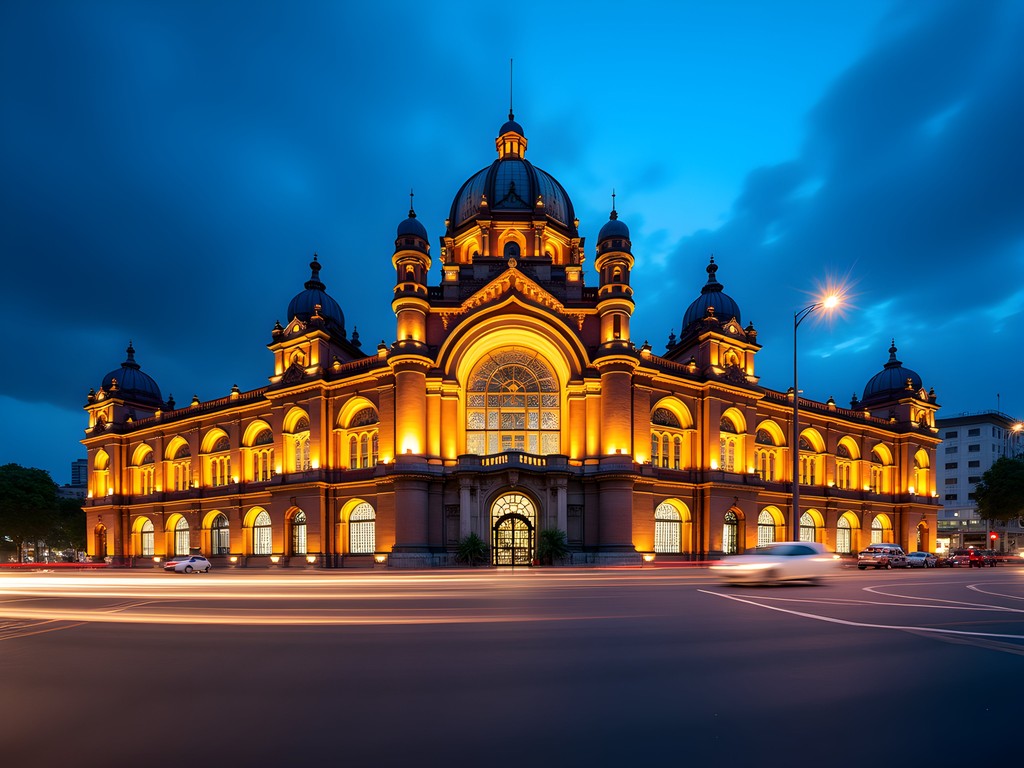
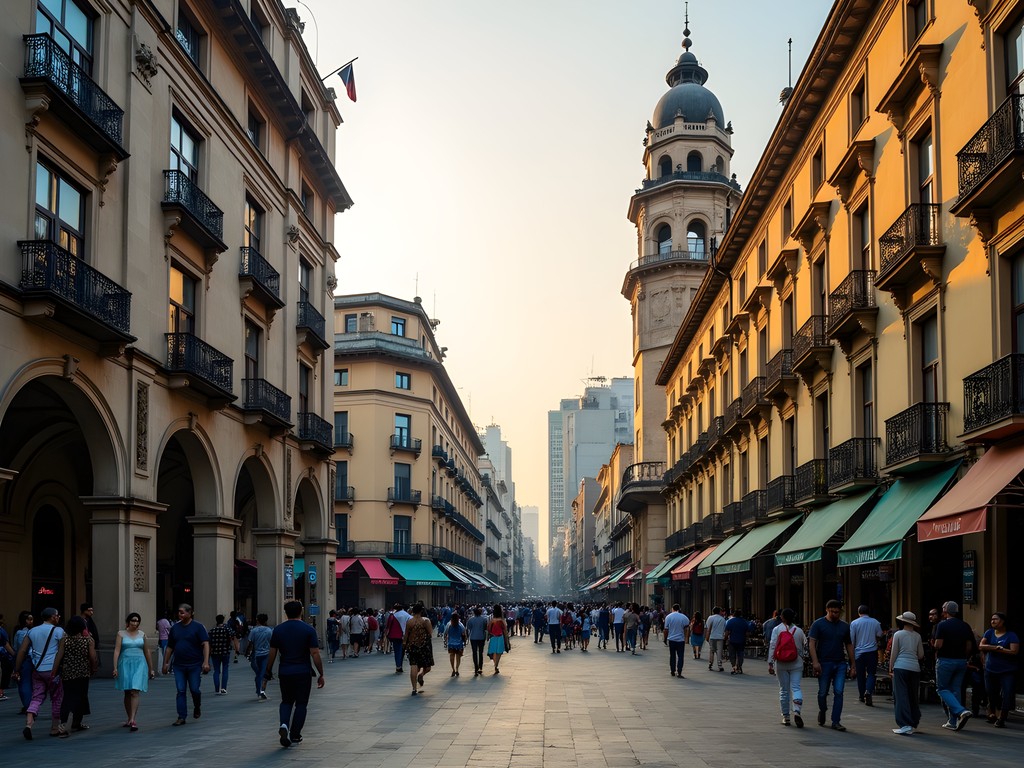
💡 Pro Tips
- Visit CST Station during blue hour (20-30 minutes after sunset) for the perfect balance of artificial and natural light
- Use a tripod for long exposures that capture both architectural details and the movement of people/vehicles
- In Kala Ghoda, look for frames where contemporary elements interact with colonial architecture
Urban Contrasts: Dharavi & Worli Fishing Village
Understanding Mumbai requires engaging with its contrasts—nowhere more evident than in the juxtaposition of its informal settlements and fishing villages against the backdrop of skyscrapers and luxury developments.
Dharavi, one of Asia's largest informal settlements, presents complex ethical considerations for photographers. I approached this area only with a local guide who maintains relationships with community members and businesses. Rather than focusing on poverty narratives, I sought to document resilience, craftsmanship, and community—the recycling industries, pottery workshops, and textile manufacturing that form the economic backbone of this neighborhood.
Photographically, Dharavi challenges you to find light in narrow lanes and to compose thoughtfully in busy spaces. I found a 35mm prime lens ideal for this environment—wide enough to capture context but not so wide as to distort or create an exploitative perspective. The most compelling images emerged when I spent time in one location, becoming familiar enough that my presence faded into the background, allowing natural moments to unfold.
Worli Fishing Village offers a different face of traditional Mumbai persisting alongside modernity. This centuries-old koliwada (fishing settlement) sits literally in the shadow of luxury high-rises, creating striking visual juxtapositions. Arriving early morning (around 6:30 AM) allowed me to photograph fishermen preparing their nets with the dramatic backdrop of the Bandra-Worli Sea Link and modern skyline.
The village's narrow pathways, colorful houses, and fishing boats create a photographer's playground of composition possibilities. I found myself drawn to frames where traditional fishing elements appeared against modern architectural backgrounds—the visual story of Mumbai's development and the communities maintaining traditional livelihoods within that context.
Both locations require sensitivity and respect. Always ask permission before photographing individuals, be prepared to explain your purpose, and consider bringing printed photos on a return visit as a way of giving back. These images may become some of your most meaningful from Mumbai—documenting not just picturesque scenes but the complex social fabric that makes this city unique.

💡 Pro Tips
- Visit Dharavi only with a reputable local guide who has community connections
- Focus on craftsmanship and industry rather than poverty narratives
- At Worli Village, arrive early morning to capture fishing preparations with dramatic city backdrops
Architectural Marvels: Bandra-Worli Sea Link & Antilia
Mumbai's skyline has transformed dramatically in recent decades, with contemporary architectural statements creating new photographic icons alongside colonial and traditional structures.
The Bandra-Worli Sea Link—officially the Rajiv Gandhi Sea Link—presents a masterclass in modern infrastructure photography. This 5.6km cable-stayed bridge connects the western suburbs to South Mumbai, creating sweeping curves across the Arabian Sea. While many photographers capture it from afar, I discovered that the structure itself offers compelling abstract possibilities.
My favorite vantage point came from Bandra Fort at sunset, where the bridge appears to stretch endlessly into the horizon. Using my telephoto lens allowed me to compress the perspective, emphasizing the repeating patterns of cables against the colorful sky. Another rewarding approach was to photograph from Worli Seaface during blue hour, when the bridge's illumination creates dramatic reflections on the water.
For architectural photographers interested in contemporary design, Antilia—the private residence of business magnate Mukesh Ambani—offers a controversial but undeniably striking subject. This 27-story structure incorporates hanging gardens, multiple architectural styles, and a distinctive vertical garden façade. While security restrictions prevent close-up photography, compelling images can be created from Altamount Road, particularly when including elements that provide scale context.
Nearby, the World Towers complex and Imperial Towers create additional opportunities for architectural photography that captures Mumbai's aspirational vertical growth. I found the most interesting compositions came from seeking reflections in surrounding buildings or using street elements as framing devices.
For these modern architectural subjects, I often employed techniques that differ from my approach to historic buildings—embracing abstract compositions, seeking reflections, and sometimes intentionally distorting perspective to emphasize scale and ambition. The resulting images tell a story about Mumbai's evolution and its position as a global city with architectural ambitions to match its economic growth.
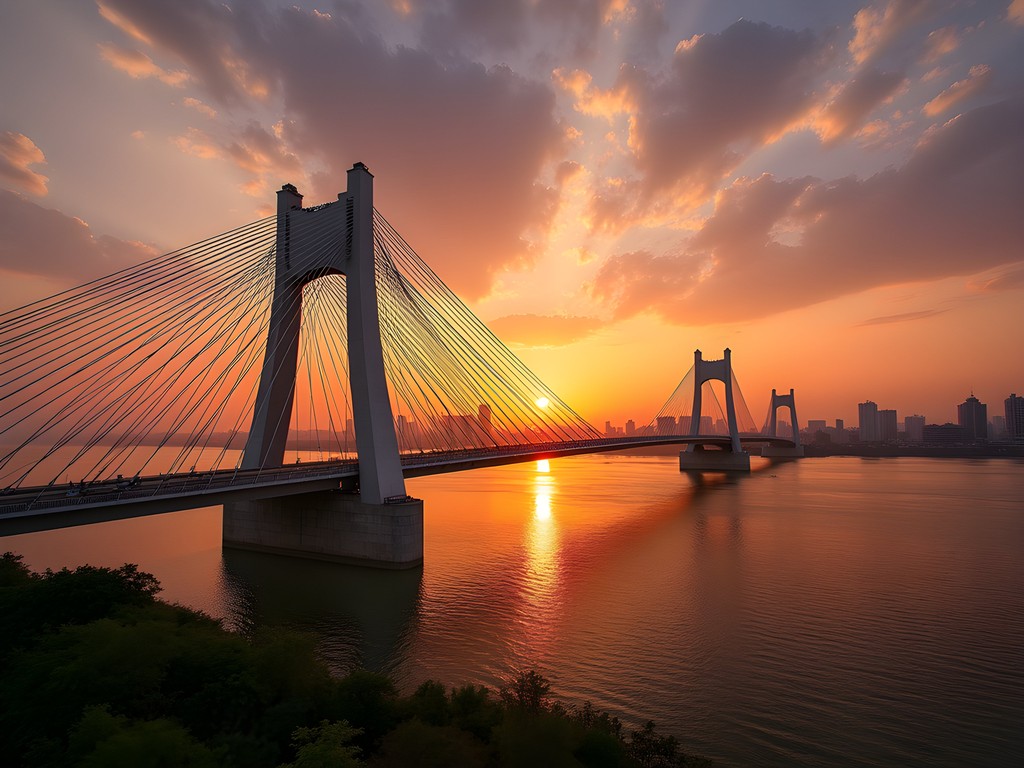
💡 Pro Tips
- For Sea Link photography, visit Bandra Fort at sunset or Worli Seaface during blue hour
- Use a telephoto lens to compress perspective and emphasize the bridge's repeating patterns
- When photographing modern skyscrapers, look for reflections in surrounding glass buildings
Cultural Immersion: Crawford Market & Chor Bazaar
For photographers seeking to capture Mumbai's sensory richness and human stories, the city's historic markets offer unparalleled opportunities. These bustling commercial spaces have remained largely unchanged for generations, providing a window into everyday life and commerce.
Crawford Market (officially Mahatma Jyotiba Phule Market) occupies a historic building designed by British architect William Emerson. The structure itself—with its Norman and Flemish architectural elements—deserves careful documentation, but it's the activity within that creates the most compelling photographic narratives. The market's sections dedicated to fruits, vegetables, spices, and household goods create distinct color stories and compositional opportunities.
I found early morning (around 8 AM) ideal for photography here—the light filtering through the high windows creates atmospheric rays, and vendors are busy arranging their displays. This timing offers the perfect balance between activity and navigability before the midday crowds arrive.
For street photographers, the challenge lies in capturing authentic moments amid the bustle. I discovered that finding a fixed position and waiting for compositions to form naturally yielded better results than constantly moving. Patience revealed perfect moments—a vendor tossing mangoes to his colleague, the precision of a spice merchant measuring saffron, the negotiations between shoppers and sellers.
Chor Bazaar (Thieves Market) presents an entirely different photographic experience. This labyrinth of narrow lanes specializes in antiques, vintage items, and repurposed goods. The dense visual texture—stacks of furniture, collections of old cameras, piles of automotive parts—creates rich compositional possibilities. The subdued lighting in many shops adds atmospheric quality, though it presents technical challenges.
I found my prime lens invaluable here, allowing me to work in low light while maintaining image quality. The shopkeepers themselves often became my most interesting subjects—many have operated their businesses for decades and carry stories that add depth to any photographic project on Mumbai.
In both markets, building rapport before photographing is essential. I made small purchases, engaged in conversation, and always asked permission before capturing people. This approach not only yields more authentic images but transforms the photographic process into a meaningful cultural exchange.
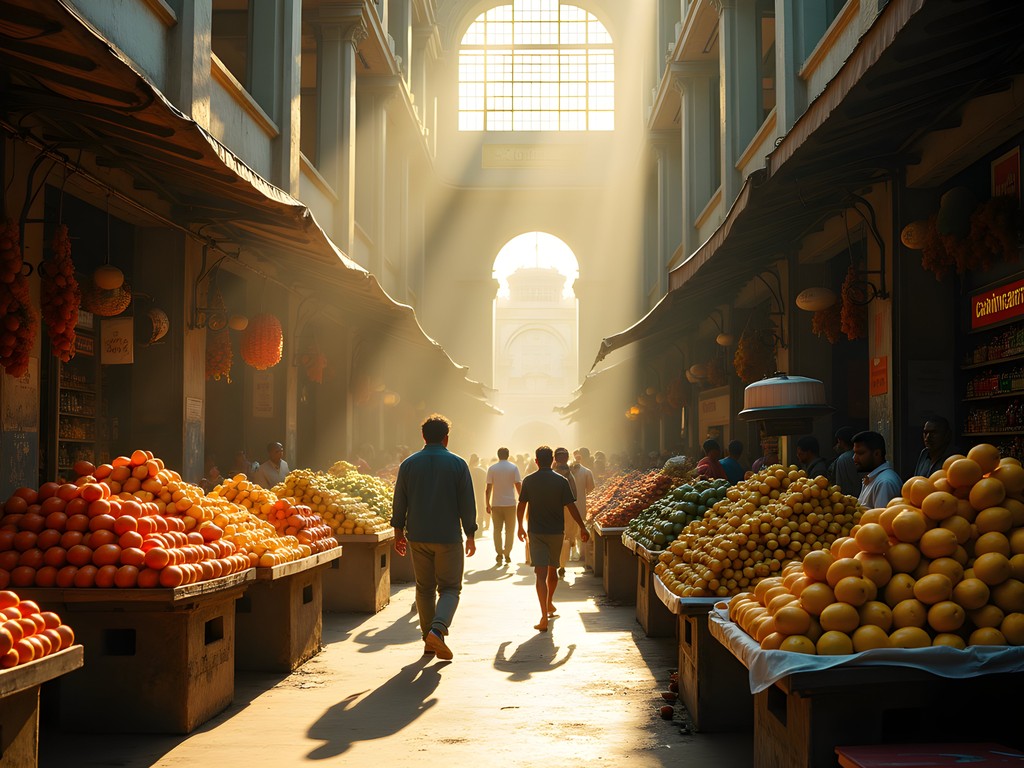
💡 Pro Tips
- Visit Crawford Market early morning (8-9 AM) when light rays filter through windows
- At Chor Bazaar, bring a fast prime lens for low-light conditions
- Make small purchases and build rapport with vendors before photographing them
Twilight Magic: Bandra Bandstand & Marine Drive by Night
Mumbai transforms as daylight fades, revealing a city defined by illumination against the darkness of the Arabian Sea. For photographers, the twilight and nighttime hours offer distinctive opportunities to capture the metropolis in its most glamorous light.
Bandra Bandstand presents one of Mumbai's most romantic promenades, stretching along the coastline with views across to the illuminated skyline of South Mumbai. I arrived about 30 minutes before sunset to secure a position along the sea wall. As the golden hour transitioned to blue hour, the distant skyscrapers began to illuminate, creating a perfect backdrop for silhouettes in the foreground.
What makes Bandstand photographically compelling is the layering of elements—couples sitting on the sea wall, the rhythmic patterns of waves against rocks, and the glittering cityscape beyond. I experimented with long exposures using my neutral density filter to smooth the water while maintaining the sharpness of the skyline, creating a dreamy quality that captures Mumbai's romantic evening atmosphere.
Marine Drive by night offers a completely different nocturnal experience. The curved promenade's streetlights create the famous 'Queen's Necklace' effect—a string of pearls wrapping around the bay. While this view is often photographed from high vantage points like Malabar Hill, I found that ground-level perspectives along the promenade itself yielded more interesting compositions.
Positioning myself near Chowpatty Beach end of Marine Drive around 8 PM, I used a wide-angle lens to capture the sweeping curve of lights. The constant flow of traffic creates rivers of red and white light trails when photographed with longer exposures (15-30 seconds). Including elements like the distinctive silhouette of Nariman Point buildings or the art deco structures along the drive helps establish a sense of place beyond the abstract light patterns.
Both locations require patience and technical preparation—a sturdy tripod is essential, as is familiarity with your camera's long exposure settings. The effort pays dividends in images that capture Mumbai's nocturnal personality—a city that never truly sleeps but simply shifts its energy from daylight commerce to evening promenade.
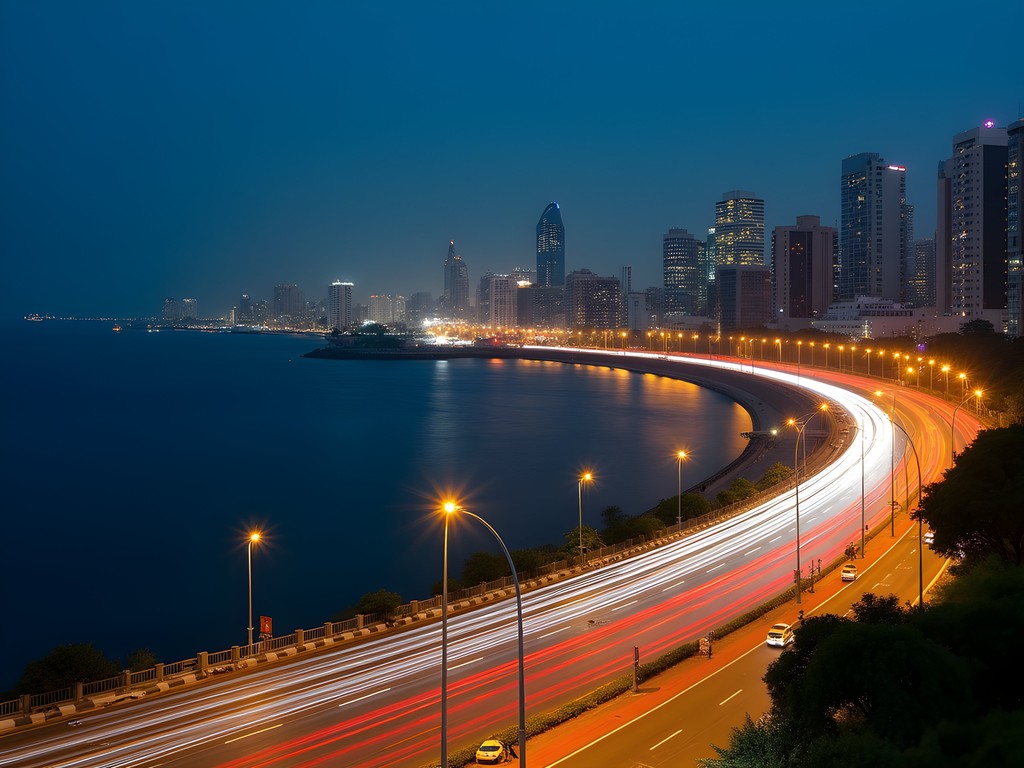
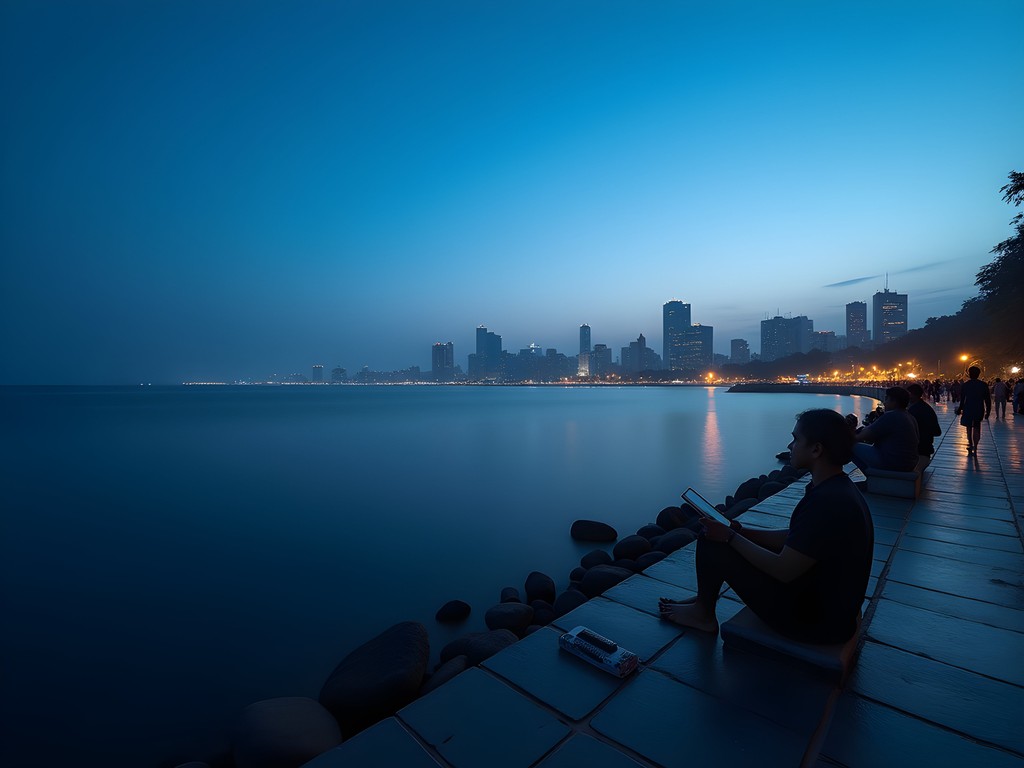
💡 Pro Tips
- Arrive at Bandstand 30 minutes before sunset to secure a good position and capture the transition to blue hour
- Bring a tripod and remote shutter release for sharp long exposures
- At Marine Drive, experiment with exposure times between 15-30 seconds to capture traffic light trails
Final Thoughts
As I pack away my camera on my final evening in Mumbai, I'm struck by how photographing this city has deepened my connection to my Indian heritage. Mumbai doesn't offer easy photography—it demands patience, cultural sensitivity, and technical adaptability. But those who approach it with respect and curiosity will be rewarded with images that transcend tourist snapshots, capturing instead the complex soul of a metropolis balancing tradition and transformation. The 15 locations I've shared represent just a fragment of Mumbai's photographic potential—each neighborhood, each street corner contains visual stories waiting to be discovered. Whether you're documenting colonial architecture bathed in golden light, the intricate dance of commerce in historic markets, or the juxtaposition of fishing villages against modern skylines, remember that your most powerful images will emerge when you slow down enough to see beyond the obvious. Mumbai awaits your lens—come with empty memory cards, charged batteries, and most importantly, an open heart.
✨ Key Takeaways
- Early morning and blue hour offer the most magical light for Mumbai photography
- Building rapport before photographing people creates more authentic images and meaningful experiences
- Juxtapositions between traditional and modern elements tell Mumbai's most compelling visual stories
- Technical versatility (from wide-angle to telephoto, day to night photography) allows you to capture Mumbai's diverse facets
📋 Practical Information
Best Time to Visit
November to February (winter)
Budget Estimate
$50-100 per day excluding accommodation
Recommended Duration
Minimum 5-7 days
Difficulty Level
Intermediate
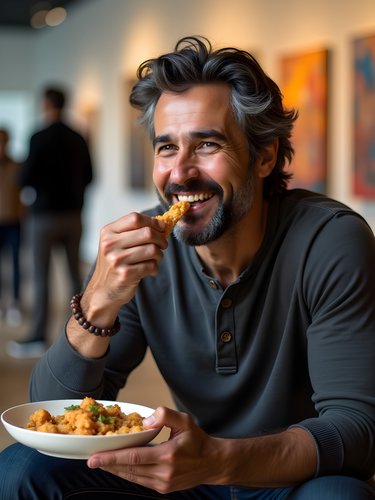


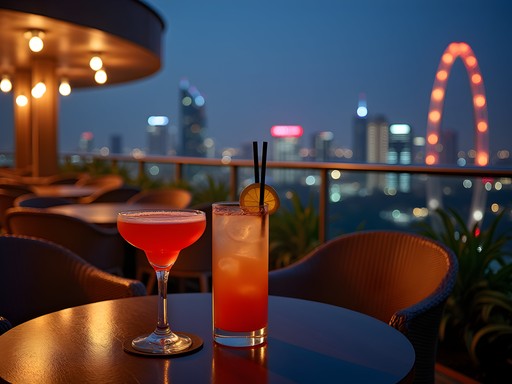
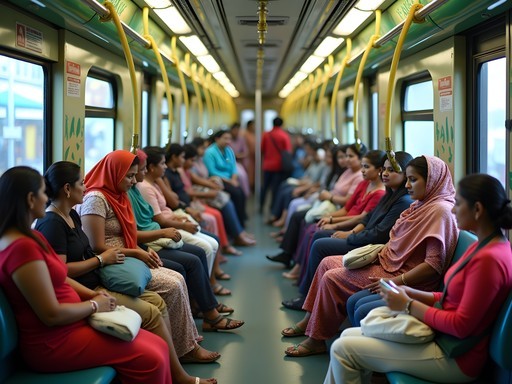
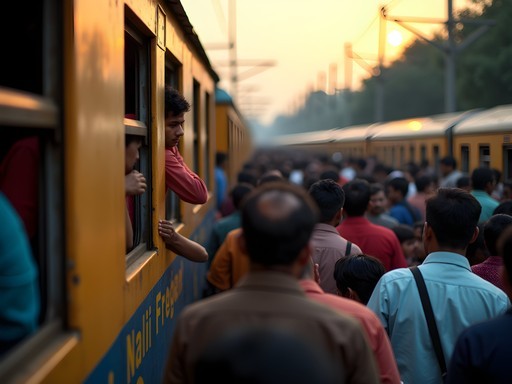
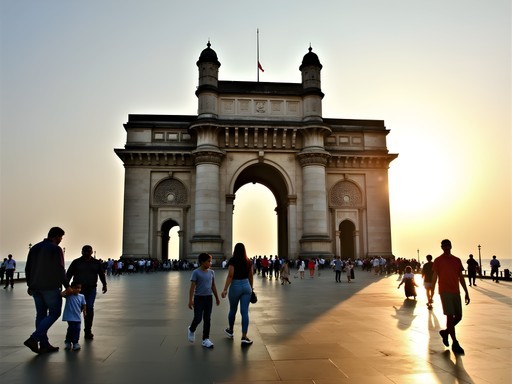
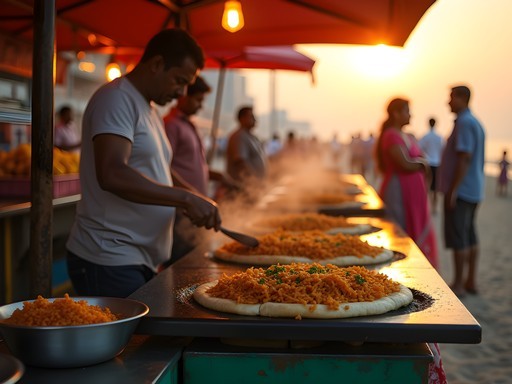
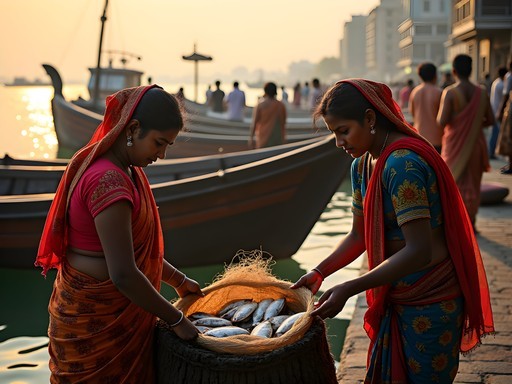

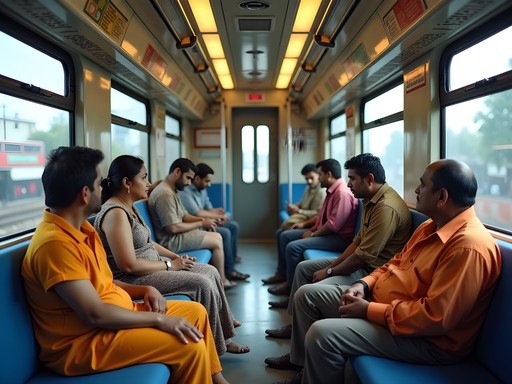
Comments
oceanfan
Wow, those Haji Ali Dargah shots are incredible! The reflection on the water is just perfect.
dreamfan
Amit, your photos capture Mumbai's soul perfectly! I visited last year and struggled to photograph the Gateway of India without hordes of tourists. Your tip about going at sunrise is gold - wish I'd known that before. The Dharavi section really moved me too. It's refreshing to see someone approach it with respect rather than just poverty tourism. Did you feel safe walking around with your camera gear in some of the more crowded areas?
Amit Sanchez
Thanks so much, dreamfan! For safety, I kept my gear minimal - just one camera body and a versatile lens. Mumbai is generally safe for photographers but staying aware of your surroundings is key. I also made a point to chat with locals before taking photos in residential areas. Did you manage to visit Banganga Tank?
dreamfan
Unfortunately missed Banganga Tank! Adding it to my list for next time. Thanks for the tips about keeping gear minimal - makes total sense.
exploregal
Just got back from Mumbai and wish I'd seen this post before going! The Worli fishing village was such a hidden gem - those colorful boats against the sea backdrop with the Bandra-Worli bridge in the distance... pure magic! Did anyone else try the street food while photographing? Those vada pav shots with the steam rising were worth the minor stomach upset lol!
photowalker
The food photography is half the reason I'm going! Did you find any particular stalls that were especially camera-friendly?
exploregal
The vendors near Chowpatty Beach were super friendly! They even posed with their colorful chaat displays when they saw my camera. Just buy something after taking photos - good manners!
starclimber
Is it safe to carry expensive camera gear around Mumbai? Any tips for keeping equipment secure while still getting great shots?
Hannah Woods
I've found Mumbai generally safe for photography, but I use a camera bag with security features. Keep gear close in crowded areas like train stations, and I usually bring just 1-2 lenses when exploring markets. Local people are incredibly helpful if you're respectful!
starclimber
Thanks Hannah! That's really helpful. I've been nervous about bringing my good camera.
Hannah Woods
Your post resonates deeply with me, Amit. I visited Mumbai last year and found the juxtaposition between Dharavi and the colonial architecture particularly striking from a photographic perspective. The light quality at Banganga Tank during early morning was exceptional - though I'd add that visitors should be mindful of locals performing religious rituals there. I found the contrast between shadows and light at CST Station around 4pm created dramatic architectural shots that highlighted the Gothic details. Did you encounter any resistance when photographing in Dharavi? I found a local guide essential for navigating both the physical space and ethical considerations.
Amit Sanchez
Absolutely Hannah - I should have emphasized the importance of a local guide for Dharavi. I worked with Reality Tours who ensure photography is done respectfully and a portion of proceeds goes back to the community. And yes, that afternoon light at CST is magical!
photowalker
Your photos are stunning! Really captured the soul of Mumbai. I'm heading there in December - which lens did you use for those dawn shots at Marine Drive?
Amit Sanchez
Thanks @photowalker! I used my 24-70mm f/2.8 for most of the Marine Drive shots. Early morning (5:30-6:30am) gives you that golden glow without the crowds. Bring a microfiber cloth too - the sea spray can fog your lens!
photowalker
Perfect, thanks for the tip! Can't wait to try capturing that golden light.
SoloFemTraveler
Love this post! How safe did you feel as a solo photographer in these areas? Planning my first Mumbai trip.
Casey Andersson
Not Amit, but as a female traveler who's been to Mumbai several times - I felt quite safe during daylight hours in all these spots. For dawn shoots, I usually buddy up with another photographer or hire a local guide. Marine Drive and Gateway of India are perfectly fine solo though!
SoloFemTraveler
Thank you Casey! That's reassuring. A guide for the early morning shoots sounds like a smart idea.
TravelWithRaj
As someone born in Mumbai but raised abroad, your post hit home for me. That feeling of reconnecting with your heritage through the lens is something I experience every time I visit. Last time I was there, I spent hours at Banganga Tank just watching the light change. The locals thought I was crazy sitting in one spot for so long! One tip for anyone visiting Haji Ali Dargah for photography - check the tide times before you go. The causeway is only accessible during low tide, and the best photos are when the water is calm but still surrounds the pathway. Also, dress respectfully as it's a religious site.
Sophia Gomez
Amit, your post brought back so many memories! I was in Mumbai last month for a conference and extended my stay to explore with my camera. The contrast between Dharavi and the upscale neighborhoods really struck me too. One thing I'd add - the early morning light at Sassoon Dock when the fishing boats return is absolutely magical. The colors, the energy, the authenticity... though be prepared for the fish smell! I connected with a local photography guide through Instagram who showed me spots I'd never have found on my own. Your point about photography deepening your connection to heritage resonated deeply - my own Colombian roots feel more vivid when I'm capturing places through my lens.
travel_with_mina
The Sassoon Dock tip is gold! I'm saving that for my trip in December.
Sophia Gomez
@travel_with_mina Get there by 6am if you can! The light is perfect and the activity is at its peak. Bring small bills if you want to buy tea from the vendors there.
nomadninja
Great post! I'm heading to Mumbai next month for the first time. How safe is it to walk around with camera gear at Marine Drive during sunrise? Any tips for not looking like a total tourist?
Sophia Gomez
I was there in September! Marine Drive is actually pretty safe for photographers at sunrise - lots of locals jogging and doing yoga. Just keep your gear in a non-flashy bag when not shooting. The real magic happens around 6:30am when the light hits the buildings along the bay!
nomadninja
Thanks Sophia! That's super helpful. Did you find any spots that weren't mentioned in this post that are worth checking out?
Sophia Gomez
Definitely check out Bandra Fort at sunset! It gives you this amazing view of the Sea Link bridge with the skyline in the background. Also, the Dobi Ghat (open-air laundry) is incredible for photography, but be respectful as people are working there. I used my camera bag which was perfect - discreet but easy access for quick shots.
Venture X
Premium card with 2X miles, $300 travel credit, Priority Pass